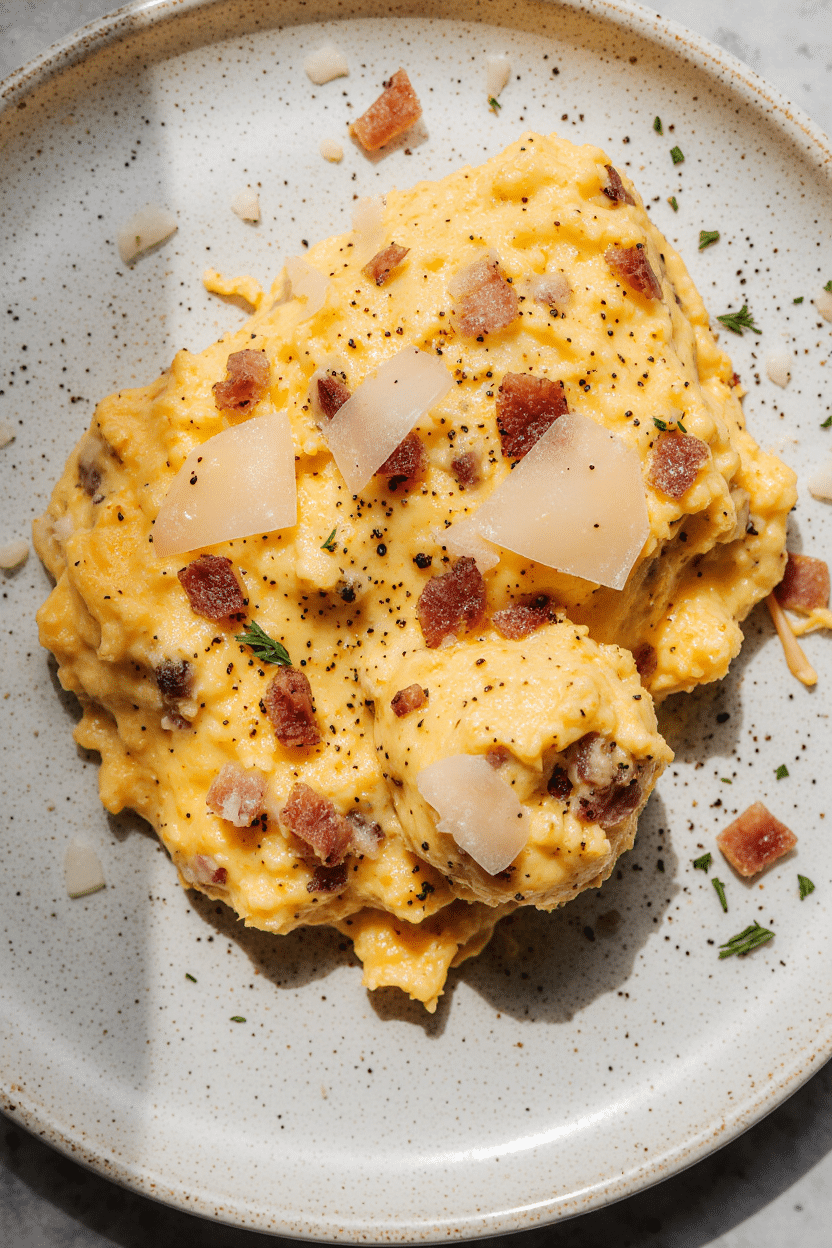This luxurious version of scrambled eggs features rich, custardy texture and bold flavor from pancetta, sharp Pecorino cheese, and lots of freshly ground black pepper. Low, steady heat is the secret to getting the perfect soft scramble. While pancetta provides a meaty bite, it can be omitted for a vegetarian variation. This dish is a sophisticated twist on a classic breakfast staple, ready in just 15 minutes.
Full Recipe:
Ingredients:
-
Eggs
-
Pancetta (optional, diced)
-
Freshly ground black pepper (generous amount)
-
Pecorino Romano cheese, finely grated
-
Butter or oil for cooking
(Exact measurements are not listed in the summary but typical for 2 servings might be: 4 eggs, 2 oz pancetta, 2 tbsp grated Pecorino, 1 tbsp butter, to taste pepper.)
Directions:
-
Cook the Pancetta:
-
In a non-stick skillet over medium heat, cook pancetta until browned and crispy. Remove and set aside.
-
-
Scramble the Eggs:
-
Reduce heat to low. Add butter to the skillet.
-
Crack the eggs into a bowl and whisk until well blended.
-
Pour eggs into the pan and stir constantly with a silicone spatula, scraping the bottom as you go.
-
-
Add Flavor:
-
Just before the eggs fully set, stir in cooked pancetta, Pecorino, and a generous amount of freshly ground black pepper.
-
-
Finish:
-
Continue cooking until the eggs are soft and just set. Serve immediately with toast, if desired.
-
Nutrients:
(Estimated per serving, based on 2 servings total)
-
Calories: ~300–350 kcal
-
Protein: ~20g
-
Fat: ~25g
-
Carbs: ~2g
-
Fiber: 0g
-
Calcium: ~150mg
Let me know if you’d like this recipe rewritten in a printable card format or adjusted for vegetarian or high-protein diets.
Why This Scramble Stands Out
Unlike traditional scrambled eggs, which are often cooked quickly over high heat, this recipe embraces patience. The secret to its custardy texture lies in the low and slow approach. Cooking the eggs over gentle heat allows the proteins to coagulate slowly, resulting in a soft, creamy consistency that’s almost sauce-like. This style, often associated with French techniques, is elevated further by savory pancetta, sharp Pecorino cheese, and a generous grind of black pepper.
Each component plays a specific role. Pancetta, an Italian cured pork similar to bacon but unsmoked, adds a salty, umami-rich note and a bit of satisfying chew. The Pecorino Romano contributes a distinct tang and sharpness, while the black pepper introduces heat and complexity. The interplay between fat, salt, and spice is what gives this dish its remarkable depth.
The Role of Heat in Perfect Scrambled Eggs
One of the most common mistakes in making scrambled eggs is using too much heat. High temperatures can cause eggs to overcook quickly, resulting in a rubbery texture and weeping liquid. In contrast, low heat allows for better control and even cooking, which is essential for this dish’s creamy texture.
The eggs should be stirred constantly with a silicone spatula, allowing you to scrape the bottom of the pan and redistribute the eggs as they slowly thicken. The moment the eggs begin to set—but are still glistening and soft—is when they’re ready. Timing is everything. Overcooking by even 30 seconds can compromise the luxurious texture.
Pancetta: A Flavorful Addition (Optional but Powerful)
Pancetta adds a distinct Italian character to the dish. It’s rendered slowly in the pan to release its flavorful fat and develop a crisp texture. That fat remains in the skillet and becomes part of the flavor base for the eggs themselves, subtly enhancing every bite.
If you prefer a vegetarian version, simply omit the pancetta and proceed with butter or oil. The eggs will still benefit from the richness of the Pecorino and pepper, standing proudly on their own. However, for meat-eaters, the pancetta truly takes this dish to the next level with its savory depth.
The Brilliance of Pecorino Romano
Pecorino Romano cheese is a bold choice for scrambled eggs—and that’s precisely why it works so well here. Made from sheep’s milk, this hard, salty cheese has a bracing sharpness that complements the richness of eggs beautifully. Its granular texture allows it to melt quickly and evenly, integrating into the eggs without overpowering them.
Compared to milder cheeses like cheddar or gouda, Pecorino offers a more assertive flavor profile, lending a gourmet quality to what might otherwise be a simple dish. Its saltiness also means you won’t need to add much extra seasoning.
Black Pepper: The Unsung Hero
No ordinary seasoning, freshly ground black pepper is a critical ingredient in this recipe. Not only does it provide contrast to the richness of the eggs and cheese, but its aromatic oils add a depth of flavor that enhances the overall dish. You’ll want to be generous with it—this isn’t the time for a mere sprinkle.
Using freshly cracked black pepper instead of pre-ground also makes a noticeable difference. The flavor is more vibrant and pungent, bringing a touch of complexity that elevates each bite. The combination of pepper and Pecorino, in particular, nods subtly to the classic Roman pasta dish cacio e pepe.
A Recipe Built on Simplicity and Precision
What makes this dish so elegant is not a long list of ingredients or complicated techniques. It’s the precision with which simple ingredients are treated. Every element—eggs, fat, cheese, and seasoning—serves a purpose and contributes to the final experience. Nothing is wasted or superfluous.
This recipe encourages the cook to slow down and be present in the process. Scrambling eggs on low heat with constant attention is almost meditative, a reminder that cooking can be both functional and soulful. It’s about turning everyday cooking into a meaningful ritual.
Nutritional Insight: Indulgent Yet Balanced
Despite its rich flavor and texture, this dish isn’t nutritionally over-the-top. With around 300–350 calories per serving and a healthy balance of protein and fat, it offers satiety and fuel without unnecessary carbs. The Pecorino brings calcium, and the eggs deliver essential amino acids and vitamins like B12 and D.
If served with whole grain toast or a side of sautéed greens, it becomes part of a well-rounded breakfast or light meal. For those watching their carbs or following a high-protein diet, it fits beautifully into many nutritional plans.
Perfect Pairings and Serving Ideas
While this dish is perfectly satisfying on its own, pairing it with complementary flavors can create a full meal. A slice of toasted sourdough or rustic country bread is ideal for soaking up any remaining richness on the plate. You might also consider pairing the scramble with fresh tomatoes, arugula salad, or lightly roasted asparagus for contrast and freshness.
For beverages, a strong cup of black coffee or an espresso makes a classic partner, though it also works beautifully with herbal teas or a mimosa for brunch occasions.
Versatility for Different Occasions
This recipe’s flexibility means it’s suitable for multiple settings. It can be the star of a luxurious solo breakfast, the centerpiece of a brunch gathering, or even a comforting weeknight dinner when you’re short on time but want something satisfying.
You can also play with variations—swapping the Pecorino for Parmesan, folding in herbs like chives or parsley, or even topping with a soft poached egg for added decadence. The base technique stays the same, allowing for creative reinterpretation.
Conclusion: Elevating the Everyday with Care and Flavor
This luxurious scrambled eggs recipe reminds us that great food doesn’t have to be complicated. With thoughtful technique, quality ingredients, and a bit of patience, even the simplest dish can become an indulgent experience. The creamy texture, rich pancetta, tangy Pecorino, and bold black pepper create a harmony of flavor that feels both comforting and sophisticated.
It’s not just breakfast—it’s a quiet celebration of craftsmanship and flavor. Whether you’re treating yourself or cooking for someone special, this dish proves that elegance can be achieved in just 15 minutes. All it takes is care, curiosity, and a willingness to slow down in the kitchen.

